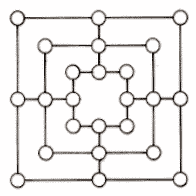The Plantation Community
Lesson Five
CHILD'S PLAY
READ AND DISCUSS
Children in the 1700s didn't have as much time to play as children today. The Masons were in school for most of the day. Children of slaves and other workers had jobs to do. Still, everyone found time just for fun.
It's hard to believe, but people thought that some outdoor games were only proper for boys. Girls had their own guessing and singing games, which were less active than the boys' games. However, many games like Nine Men's Morris were played by both boys and girls -- and even by adults.
ACTIVITY 1: Nine Men's Morris
(in pairs)
1. Find a partner.
2. Draw the board below on paper (at least 16" by 16") or on the blacktop outside. This board is three squares. One fits within the other.
3. The game is played on the 24 points on the board. These points are the corners of the three squares (there are 12) and the places where the lines cross the sides of the squares (also 12). Mark each point with an "x."
4. You and your partner each has nine men. Find nine disks or buttons for the men. Nine should be of one color and nine of another color.
5. Draw lots to see who goes first. Then, take turns placing men on empty points on the board. When you're done, there should be six empty places.
6. After all the men are on the board, take turns moving your men to the empty places. You can only move a man to a point which is above, below, or to the side of it. You may move a man to a point two spaces away if both spaces are empty and if there is not a corner in between.
7. As you move around the board, your object is to make a row of three of your men. Each row of three men is called a "mill."
8. Every time you make a mill, you take away one of the other player's men. You cannot take away a man from one of your partner's mills until there are no other men left. Once you take away a man from the board, it does not return into play.
9. When placing your men, you may "open" or break into one of your mills by moving one of your three men off the row. Later, you may "close" the mill by returning the man to its original position. Every time you make a mill, you may take away another of your partner's men. However, if your mill is "open" and your partner forms a mill of his own, he may take away one of your men from the "open" mill.
10. You can win at Nine Men's Morris two ways:
a). when the other player has only two men left.
b). when the other player's men are blocked.
11. Some players allow the last three men to move "wild" -- from one point on the board to any other point.
ACTIVITY 2: Saa Sa Bre Wa
(played with a group of any size)
This African game may have been played by slave children in America.
1. Sit down in a circle on the floor or grass. Each player has a block in front of him. All blocks should be about the same size.
2. This game contains a verse in African. Practice the words as a group:
Saa sa bre wa, a deshia*
Saa sa bre wa
Saa sa bre wa, a deshia
Saa sa bre wa
* Phoentic Pronunciation: SAH SAH BRAY WAH, AH DEE' SHAH
3. There is a group leader who directs the pace of the verse and if possible, keeps the beat with a drum. This person sits outside the circle.
4. The leader begins the verse and everyone joins him. While keeping the rhythm, each player places his block in front of the person on his RIGHT.
5. If a player misses the beat, drops the block, throws it, or fails to pick it up, he is OUT of the game.
6. When a player is out, the verse stops. The player moves out of the circle. Then, everyone counts to five and begins the verse again.
7. As players go out, the verse gets faster and faster. Continue playing until only two players are left -- the verse now is very fast! At the end, the player left in the circle is the winner.
What could children learn by playing this game?
Directions for "Saa Sa Bre Wa," taught on a videotape by Paul Ofori-Ansah, were provided through the courtesy of The Colonial Williamsburg Foundation.
  |

